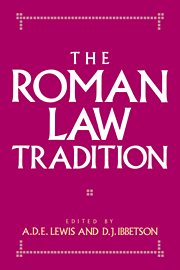Book contents
- Frontmatter
- Contents
- List of contributors
- Foreword: Peter Stein, Regius Professor of Civil Law in the University of Cambridge, 1968–1993
- List of abbreviations
- 1 The Roman law tradition
- 2 Labeo and the fraudulent slave
- 3 Doing and causing to be done
- 4 The danger of definition: contrectatio and appropriation
- 5 Going to the fair – Jacques de Révigny on possession
- 6 Bembo giureconsulto?
- 7 Gentilis and the interpretatio duplex
- 8 Ius gentium in the practice of the Court of Admiralty around 1600
- 9 Stair's title ‘Of Liberty and Servitude’
- 10 The actio communi dividundo in Roman and Scots law
- 11 Sale and transfer of title in Roman and Scots law
- 12 ‘What Marcellus says is against you’: Roman law and Common law
- 13 Audi et alteram partem: a limit to judicial activity
- Index of sources
- Index of names and subjects
3 - Doing and causing to be done
Published online by Cambridge University Press: 08 October 2009
- Frontmatter
- Contents
- List of contributors
- Foreword: Peter Stein, Regius Professor of Civil Law in the University of Cambridge, 1968–1993
- List of abbreviations
- 1 The Roman law tradition
- 2 Labeo and the fraudulent slave
- 3 Doing and causing to be done
- 4 The danger of definition: contrectatio and appropriation
- 5 Going to the fair – Jacques de Révigny on possession
- 6 Bembo giureconsulto?
- 7 Gentilis and the interpretatio duplex
- 8 Ius gentium in the practice of the Court of Admiralty around 1600
- 9 Stair's title ‘Of Liberty and Servitude’
- 10 The actio communi dividundo in Roman and Scots law
- 11 Sale and transfer of title in Roman and Scots law
- 12 ‘What Marcellus says is against you’: Roman law and Common law
- 13 Audi et alteram partem: a limit to judicial activity
- Index of sources
- Index of names and subjects
Summary
Why did both the Roman and the English law of civil wrongs adopt, and override, causal tests which were embarrassingly, even absurdly, restrictive? This paper, a token in recognition of a debt to Peter Stein, suggests an answer. Harm-verbs in the active voice drove the law into a causal corner. A system which imposes liability on a person who does (damages, injures, wounds, breaks, spills) will be forced to define doing narrowly and will have to supplement the liability for doing with another for causing to be done (be damaged, injured, wounded, broken, spilled). This effect becomes stronger as the harm-verb is tied more closely to physical damage. It is stronger for ‘break’ than ‘harm’ itself. Defendants will compel the law to look for the act of breaking. The image of a person doing that act cannot admit much intervention between the defendant's bodily movements and the thing broken.
The seeming absurdities have nothing to do with competitions between concepts of liability different from our own, much less with the pursuit of different socio-economic goals. Litigation was caught up in the implications of the words in which it happened to be conducted. The modern law school, with the help of procedural reforms, is able to debate ideas detached from actional forms. When it looks at the past, it must learn to read the semantic constraints imposed by forms of action precisely as constraints, not as evidence of a different mind-set.
- Type
- Chapter
- Information
- The Roman Law Tradition , pp. 32 - 53Publisher: Cambridge University PressPrint publication year: 1994

